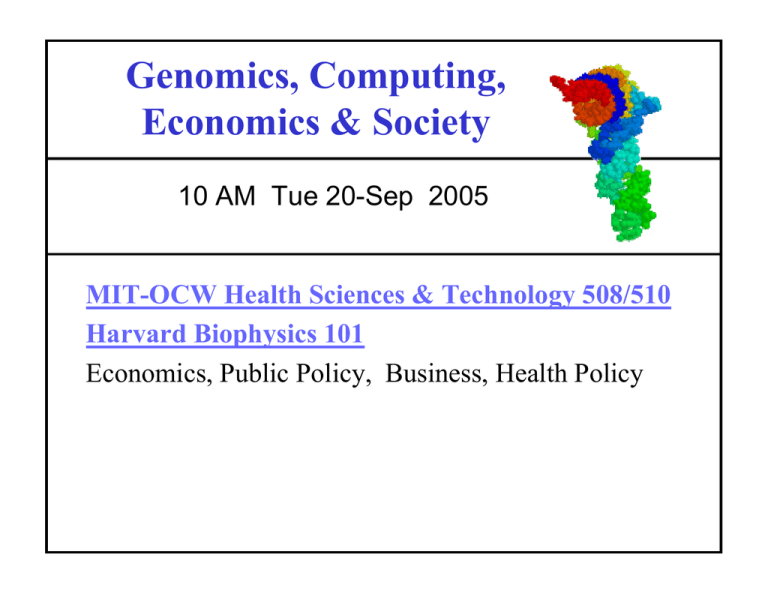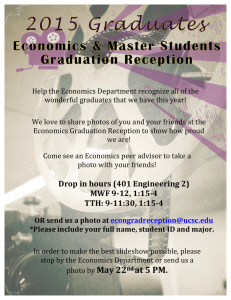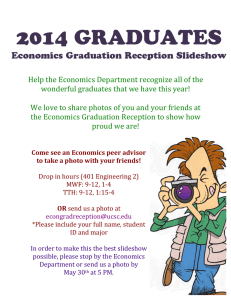Genomics, Computing, Economics & Society MIT-OCW Health Sciences & Technology 508/510
advertisement

Genomics, Computing, Economics & Society 10 AM Tue 20-Sep 2005 MIT-OCW Health Sciences & Technology 508/510 Harvard Biophysics 101 Economics, Public Policy, Business, Health Policy Genomics, Computing, Economics & Society Course plan Photo removed due to copyright reasons. Each student will participate in a class-wide project to provide decision-making tools for global/local technology development and deployment. Each will have a web page or wiki describing and updating their part of project going by the second class. Grades will be based on 25% participation(round robin), 25% personal wiki page (weekly) 25% contribution to group project/ article, 25% peer evaluations No prerequisites. It is assumed that each of you brings some expertise to be integrated with the goals and talents of other team members. Each student should make this clear at the start of the project and update it as the course proceeds. Genomics, Computing, Economics & Society Course plan Photo removed due to copyright reasons. This course will focus on understanding aspects of modern technology displaying exponential growth curves and the impact on global quality of life through a weekly updated class project integrating knowledge and providing practical tools for political and business decision-making concerning new aspects of bioengineering, personalized medicine, genetically modified organisms, and stem cells. Interplays of economic, ethical, ecological, and biophysical modeling will be explored through multi-disciplinary teams of students, and individual brief reports. Specific (standard) skills to be developed: statistics, modeling, datamining, systems biology, technology development. 101: '99-'03 Simple to Complex '05 Complex to Simple '03 5 problem sets & project '05 Project starts on day 1 Figure removed due to copyright reasons. '03 one 2 hr ppt lecture + 1.5 hr section per week '05 two 1.5 hr discussion (may include 30' ppt) '03 Project teams or 1 or two students '05 Project team of all students & TFs '03 Choice of two campuses & streaming video '05 Less choice '03 Tools: Perl & Mathematica '05 Wiki (& anything else) Previous class projects André Catic, Cal Collins, George Church, Hidde Ploegh, HL (2004) Preferred in vivo ubiquitination sites. Bioinformatics 20: 3302-7. Andrew Tolonen, Dinu Albeanu, Julia Corbett, Heather Handley, Charlotte Henson & Pratap Malik (2002) Optimized in situ construction of oligomers on an array surface. Nucleic Acids Research, 30: e107 Hui Ge, George Church, Marc Vidal (2001) Correlation between transcriptome and interactome data obtained from S. cerevisiae. Nature Genetics, 29:482-6. John Aach, Martha Bulyk, George Church, Jason Comander, Adnan Derti, Jay Shendure (2001) Computational comparison of two draft sequences of the human genome. Nature 409, 856-859. Photo removed due to copyright reasons. 3 Exponential technologies (synergistic) Computation & Communication (bits/sec) 1E+13 1E+11 1E+9 1E+7 operons Synthesis (daltons) 1E+5 urea 1E+3 tRNA B12 1E+1 1E-1 E.coli Analysis (bp/$) tRNA telegraph 1E-3 1830 1850 1870 1890 1910 1930 1950 1970 1990 2010 Shendure J, Mitra R, Varma C, Church GM, 2004 Nature Reviews of Genetics. Carlson 2003 ; Kurzweil 2002; Moore 1965 101: '99-'03 Simple to Complex '05 Complex to Simple Common ground for conservative, liberal, religious & atheist? • What is life? Should we construct from scratch? • Did life evolve using intelligent design? • When does human life begin? • Stem cells & therapeutic cloning? Can we compare Apples & oranges? • Should we buy iron-lungs or polio-vaccine research? • Do we invest in anti-terrorism or anti-malaria? Photos removed due to copyright reasons. Hot buttons Evolution Stem Cells Photo removed Life extension due to copyright reasons. Eugenics, race Privacy Security, Terrorism Genetically modified organisms - GMOs Intelligent machines Replicating machines Withholding experimental drugs (e.g. HIV & Cancer) Gender Do no harm, abortion Substance abuse Vioxx Initial Reading • Limits to Growth, The 30-Year Update by Donella H. Meadows, Jorgen Randers & Dennis L. Meadows 2004 • Freakonomics by Levitt & Dubner 2005 • As the Future Catches You by Juan Enriquez 2000 • Genetic Programming IV: Routine Human-Competitive Machine Intelligence by John R. Koza et al. 2003 • Consilience by E.O. Wilson 1998 • Redesigning Humans by Gregory Stock 2002 • Scientific Conquest of Death 2004 • Collapse by Jared Diamond 2005 • The Tipping Point by Malcolm Gladwell 2000 • The Wisdom of Crowds by James Surowiecki 2004 • The Climate Of Man by Elizabeth Kolbert 2005 • Widescale Biodiesel Production from Algae by Michael Briggs, • Synthetic Life by WW Gibbs 2004 • Personalized medicine by Francis S. Collins 2005 Photos removed due to copyright reasons. It seemed like a good idea at the time. Crops River life Grain trade Livestock Hygeine Insecticides Fertilizer Nuclear Power Tankers Photo removed Pets due to copyright reasons. Photo removed Malaria due to copyright reasons. Cholera Yersinia Flu & HIV Polio Silent Spring Anoxic fish TMI, Chernobyl Mussels & sea snakes Australian herbicide Human subject experimentation (not a test) 5 seconds each 1. Write your name, email, school & year. 2. Estimate 8 x 7 x 6 x 5 x 4 x 3 x 2 x 1 3. From a group "of 70 engineers and 30 lawyers: Dick is a 30 year old man. He is married with no children. A man of high motivation, he promises to be quite successful in his field. He is well liked by his colleagues." What is the probability that Dick is an engineer? 4. Write down a string of 10 random H & T characters. 5. From 10 people, how many different committees of 2 members? and of 8 members? 6. One individual has drawn 4 red balls and 1 white. Another 12 red and 8 white. What odds should each individual give that the source is 2/3 red (rather than 2/3 white)? 7. Estimate 1 x 2 x 3 x 4 x 5 x 6 x 7 x 8 Economics Nobel 2002 "Economics has been regarded as a non-experimental science, where researchers – as in astronomy or meteorology – have had to rely exclusively on field data, .. however, these views have undergone a transformation. Controlled laboratory experiments have emerged as a vital component .. & have shown that basic postulates in economic theory should be modified. .. cognitive psychologists who have studied human judgment and decision-making, and experimental economists who have tested economic models in the laboratory. .. Daniel Kahneman and Vernon Smith." (see also: Judgement under Uncertainty 1974 Science 185:1124) Cognitive bias .. includes "very basic statistical and memory errors that are common to all human beings and drastically skew the reliability of anecdotal and legal evidence & significantly affect the scientific method." High-level decisions Leon Kass, chairs the US President's Council on Bioethics, opposed IVF '78 & stem cell research '05 via 'the wisdom of repugnance' http://groups.msn.com/DebateCriticalThinkingandPhilosophy/killingimmortality.msnw http://www.orionsarm.com/books/Wisdom_of_Repugnance.html http://www.seti.org/site/apps/nl/content2.asp?c=ktJ2J9MMIsE&b=194993&ct=1324903 The Wisdom of Crowds by James Surowiecki 2004 Interracial-marriage: Perez v. Sharp, CA 1948, Loving v. Virginia, U.S. Supreme Court 1967 Photo removed due to copyright reasons. Economics & Global Ecology "much of the current enthusiasm for market based regulation stems from the results of a pilot program launched in th US in 1990. Congress amended the clean air act that year to set up a market for the permits that power plants must have to release SO2.. Supply & demand.. Market overseers need the power, analogous to the Federal Reserve's.." --W Gibbs, Sci Am 2005 Quantifying the "unquantitifiable" Interconversions in modeling Vaccines for the 21st Century http://books.nap.edu/html/vacc21/ Level I Most favorable: saves money & Quality-Adjusted Life Years(QALY) Level II < $10,000 < Level III < $100K per QALY saved < Level IV Level I candidate vaccines: • Viral: CMV vaccine for 12 year olds, Flu vaccine for 20% of the US per year. • Therapeutic vaccines: IDDM diabetes, MS, Rheumatoid arthritis • Bacterial: Streptococcus B & pneumoniae vaccine for infants & 65 year olds. • [HIV vaccines prominent already within NIH.] “A quantitative model that could be used by decision makers to prioritize the development of vaccines against a number of disparate diseases” 1985 & 1999. Biomedical Priorities "The complete conquest of cancer or heart disease would each lead to an increase of a mere 3% in mean life span in humans, i.e. about a tenth of what can be accomplished, today, in laboratory animals of delayed aging. " -- Miller, R.A. (2005) J.Am. Geriatrics Soc. 53:S284. CAUSES OF DEATH - USA - 1999 (Thousands) 1. 725 Heart Disease 2. 549 Malignant Neoplasms 3. 167 Cerebrovascular Diseases 4. 124 Chronic Pulmonary Disease 5. 98 Accidents 6. 68 Diabetes Mellitus 7. 64 Influenza & Pneumonia 8. 45 Alzheimer's Disease 9. 36 Nephritis, Nephorsis 10. 31 Septicemia 11. 29 Self-inflicted Injuries 12. 26 Liver Cirrhosis 13. 17 Primary Hypertension (Renal) 14. 17 Homicide 15. 16 Aortic Aneurysm 16. 379 All Other Causes* 2,391 Total CAUSES OF DEATH - WORLDWIDE - 1990 (millions) 1. 2. 3. 4. 5. 6. 7. 8. 9. 10. 11. 12. 6.3 Ischemic Heart Disease 4.4 Strokes 4.3 Lower respiratory tract Infections 2.9 Diarrheal Disease 2.4 Perinatal Disorders 2.2 Chronic Pulmonary Disease 13. 0.78 Liver Cirrhosis 2.0 Tuberculosis (Non-AIDS) 14. 0.75 Stomach Cancer 1.1 Measles 15. 0.59 Birth Defects (Rubella & CMV) 0.99 Traffic Accidents 16. 0.57 Diabetes Mellitus 0.95 Lung Cancers 17. 0.56 Violence (Non-war) 0.86 Malaria 18. 0.54 Tetanus 0.79 Self-inflicted Injuries 19. 0.54 Nephritis 20. 0.50 Drowning 21. 0.50 War 22. 0.50 Liver Cancer (Hepatitis B Virus) 30. 0.31 AIDS HIV-1 50.40 Total Deaths The Maslow pyramid, 1943 Figures by MIT OCW. Depolarization How do we make decisions? How do we bridge? Not "right vs wrong", nor "moral relativistic flip-flopping" • What is the maximum discrepancies between societal benefit vs actual strategies? And how do we find them convincingly? • What are the reasons for such? Do "special interests" represent lags in the knowledgebase of the decision makers. • To what extent and by what means do we avoid oscillation? Framework draft outline Working title: Prove, Predict, prioritize, practice Breaking barriers & building bridges Prove, predict: Connect problems, technologies, modeling options Example: Evolution - replicating &/or intelligent machines stem cells, abortion Model: Quantitatively define life. Prioritize, practice: Metabolic networks Example: Carbon & Energy Model: Multilevel from molecular to global. Prioritize: Privacy vs openess Example: Personal genomics Model: Evolutionary conservation, etc. Framework Draft continued Prioritize, practice: Synthetic Biology & chemistry Examples: bioecurity, bioterrorism Genetically modified organisms - GMOs Withholding experimental drugs (e.g. HIV & Cancer) Substance abuse, Vioxx Models: Risk & benefit, systems models.


